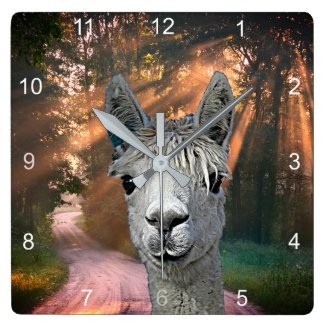PEPE THE ALPACA
ON THE ROAD WITH PEPE THE ALPACA SQUARE WALL CLOCK

On the road with Pepe the Alpaca depicts an alpaca from a farm close to where we live. We have it on a number of products. This clock sold to a customer in Germany.
The Vicugña pacos is a domesticated species of South American camelid. The camels that most people are familiar with are the ones with humps; the dromedary of Northern Africa, the Middle East, and Southern Asia, and the Bactrian camel of China and Tibet. Four other camelids (without humps) are indigenous to South America: llamas and alpacas, have been domesticated for thousands of years. The other two varieties, guanacos and vicunas, continue to roam in wild herds today.
It comes in two breed-types: huacaya (pronounced wuh‑KAI‑ya) and suri (SUR‑ee). Huacayas, the more common type, account for about 90% of all alpacas. Huacaya fiber is a bright, crimpy, soft fiber, that is well suited to knitted, crocheted, and woven applications. Suri fiber, on the other hand, is naturally silky, smooth, cool to the touch, with high luster. Suri has a natural drape which makes it perfect for flowing scarves, shawls, and gowns.
HOW ARE THESE DIFFERENT FROM LLAMAS?
People often confuse alpacas with llamas. While closely related, they are distinctly different animals. First, llamas are much larger, about twice the size of an alpaca, with an average weight of about 250 to 450 pounds, compared to an alpaca whose weight averages 120 to 200 pounds. Llamas are primarily used for packing or for guarding herds of sheep.
ARE THEY AN “EXOTIC SPECIES,” OR SIMPLY “LIVESTOCK?”
Alpacas have been raised as domestic livestock for thousands of years. Since the end-product is their fleece, like sheep, they are classified as livestock by both the United States and Canadian federal governments.
DO THEY SPIT?
All members of the camel family use spitting as a means of negative communication. They do get possessive around food, and thus may express annoyance by spitting at other alpacas that they perceive are encroaching on “their” food. Also, they often spit at one another during squabbles within the herd (usually involving two or more males). Alpacas do sometimes spit at people on purpose, but it is more common that humans get caught in the cross-fire between alpacas. It’s best to study their behavior and learn to avoid the most vulnerable situations.
DO THEY MAKE A NOISE?
Alpacas are very quiet, docile animals that generally make a minimal amount of sound. They generally make only a pleasant humming sound as a means of communication or to express concern or stress. Occasionally you will hear a shrill sound, called an “alarm call,” which usually means they are frightened or angry with another alpaca. Male alpacas also “serenade” females during breeding with a guttural, throaty sound called “orgling.”
